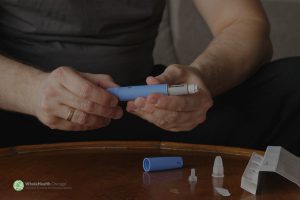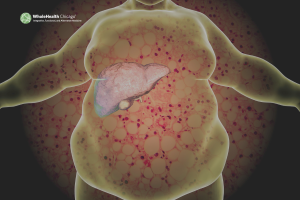You’re tired of being overweight, and you’ve been a victim of the tyranny of the last ten, fifteen, or twenty pounds as long as you can remember. You’ve tried everything. You’ve been dieting as long as you can remember and nothing happens. You exercise to exhaustion, lose some pounds and gain them back. No matter […]
Tag: diabetes
WHY THIS SUDDEN INCREASE IN “FATTY LIVER”?
I know ‘fatty liver’ has an unhealthy ring to it and all-in-all, without even knowing exactly what ‘fatty liver’ happens to be, you’d rather hear, “Your liver tests all look fine” from your practitioner then, “Hmm, need some more tests. Might have some fatty liver here.” Don’t start wringing your hands in despair, eyes Heavenward, […]
Not One Nibble More Than 25 Grams Of Sugar A Day
Of course, everyone reading this already knows that sugar is “bad” for you. It’ll make you fat, you can get addicted to it, and it causes all sorts of health problems, like early heart disease, diabetes, depression, cancer susceptibility. But recently, a massive study out of China was able to determine how much sugar taken […]
Pre-Diabetes: What It Is And What To Do
Most physicians, myself included, jot a personal comment on a patient’s lab tests. My favorite is “Everything’s excellent!” which can be typed quickly and concentrates good news into two words that I hope trigger a smile. According to a recent New York Times article, doctors are writing the sentence “Your tests show you’re now in […]
All Hail The Bean!
What a pleasant surprise to open this week’s Archives of Internal Medicine and find the results of a trial on the benefits of eating legumes–beans, lentils, and chickpeas. This was a real clinical trial, working with a group of people who had mild Type 2 diabetes. During the three-month study period, half the enrollees ate […]
Death By Cupcake
Happy Valentine’s Day! People who know me will say today’s health tip on the dangers of sugar is just typical, badgering innocent people on a holiday dedicated to love, romance, and dessert. Before we get started, let me pull out my two favorite passive-aggressive chestnuts: “I’m just looking out for your best interests” and “I […]
Polycystic Ovary Syndrome (PCOS)
PCOS is by far the most common cause of infertility in women, and the number of women with diagnosed and undiagnosed PCOS is best described as “vast.” Experts estimate that as many as 10% of women of childbearing age may have the disorder.
Women + Certain Carbs = Early Death
This is one of those “Not fair!” studies, an “Is there no justice?” piece of research that underscores the importance of gender in health.
Prickly Pear
A symbol of the Rio Grande valley, the prickly pear cactus (genus Opuntia) boasts thorny pads, colorful large flowers, and succulent fruits, and its distinctive image is proudly displayed on the Mexican flag. For centuries, native peoples living in the deserts of Mexico, the southern United States, and parts of South America relied on this robust desert plant for food and healing. Many of these traditions were carried on by European settlers, who then also transported the plant’s seeds to Europe and around the world.
Ginseng (Panax)
Look at the nutrition label on your orange juice or multivitamin and you may notice that ginseng has been added. That’s because smart marketers have caught on to this Herb’s 2,000-year-old reputation as a “feel good” tonic that can boost energy, combat the physical effects of stress, empower the immune system, improve concentration, and provide Antioxidant actions. Its legendary properties, particularly as an aphrodisiac, were once so prized in China that only the emperor was allowed to gather the herb. Today some men still take it to treat impotence and infertility although it’s unclear whether it actually improves these conditions.
Zinc/Copper
The minerals zinc and copper can be purchased as single products, but there’s good reason to consider a combination product that pairs the two.
Zinc blocks the absorption and enhances the excretion of copper when taken over time. So, when zinc is recommended long term (over many months) for any condition–from arthritis to prostate problems or even Alzheimer’s–it’s important to get some copper as well. A combination product will help prevent a copper deficiency and the anemia that can develop as a result.
Vitamin B Complex
A high-quality vitamin B complex supplement will provide, in one convenient pill, a full range of B vitamins, including biotin, choline, folic acid, inositol, PABA (para-aminobenzoic acid), and the six “numbered” B vitamins–vitamin B-1 (thiamin), B-2 (riboflavin), B-3 (niacin), B-5 (pantothenic acid), B-6 (pyridoxine), and B-12 (cobalamin). Combination products can simplify the process of taking individual B vitamins for a range of ailments including alcoholism, depression, diabetes, hair problems, lupus, multiple sclerosis, and stress.
Niacin
Also known as vitamin B3, niacin has earned a reputation (in supplement form) as a natural cholesterol-lowering agent that often rivals prescription drugs in mild to moderate cases. It may also help to prevent or treat a number of other disorders, from arthritis and depression to diabetes. Three forms of niacin supplements–each with a specific therapeutic role–are commercially available: nicotinic acid (also called nicotinate), niacinamide and inositol hexaniacinate, a compound of niacin and inositol (another B-family vitamin).
Myrtle
Myrtle (Myrtus communis), a plant native to the Mediterranean and the Middle East, has traditionally been used to treat coughs and various types of respiratory infections, such as bronchitis. It also has a reputation for promoting good digestion, treating urinary tract disorders, and preventing infections in wounds.
Magnesium
Essential for hundreds of chemical reactions that occur in the body every second, the mineral magnesium has received surprisingly little attention over the years. Recent findings, however, suggest that it also has important health-promoting benefits, from an ability to prevent heart disease to a role in treating such chronic conditions as fibromyalgia and diabetes.
Ginkgo Biloba
This popular herbal medicine is extracted from the fan-shaped leaves of the ancient ginkgo biloba tree, a species that has survived in China for more than 200 million years and now grows throughout the world. (The leaves are double, or bi-lobed; hence the name biloba.) Long used in traditional Chinese medicine, it is only in the last few decades that the medicinal uses for the herb have been studied in the West.
Fish Oils
Heralded for its heart-healthy actions, fish oils offer high concentrations of polyunsaturated fats called omega-3-fatty acids. While all fish contain these fats, cold-water fish–salmon, sea bass, tuna, trout, mackerel–are particularly rich sources because of their diet: plankton packed with omega-3s. Interestingly, the colder the water, the more omega-3s in the plankton. Cold-water fish also boast the most potent forms of omega-3s: the essential fatty acids known as eicosapentaenoic acid (EPA) and docosahexanoic acid (DHA). Consumed as part of a fish-filled diet or in supplement form, omega-3s have myriad healing powers.
Evening Primrose Oil
Evening primrose oil is extracted from the evening primrose plant (Oenothera biennis), a wildflower found in North America, Europe and parts of Asia. The plant’s pale yellow flowers open in the evening–hence its common name–and its seeds bear the special fatty oil that is used in healing today.
Chromium
Chromium is an essential trace mineral that the body needs to grow properly and remain healthy. It is necessary, among other things, for the breakdown of protein, fat, and carbohydrates.
Cayenne
Thought to have originated in Cayenne, French Guiana, cayenne is a spice derived from several varieties of dried hot peppers in the Capsicum species. Cayenne is a relative of the mild bell pepper used in salads and also of the fiery peppers found in chili powders and hot sauces, but it has no connection to black table pepper. Used for centuries by cooks around the world to add “heat” to traditional dishes, cayenne has gained a solid reputation both as a painkiller and digestive aid.


